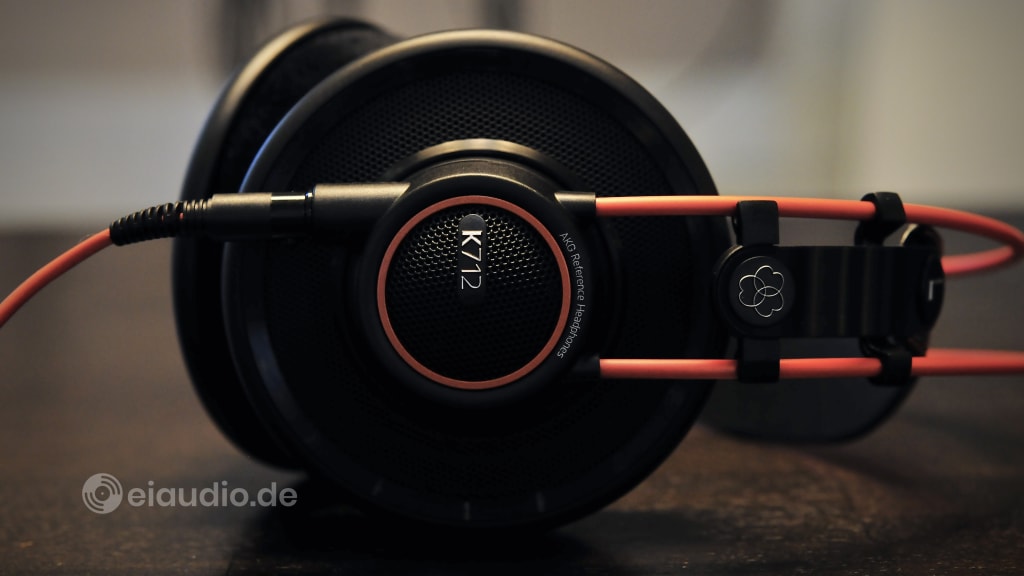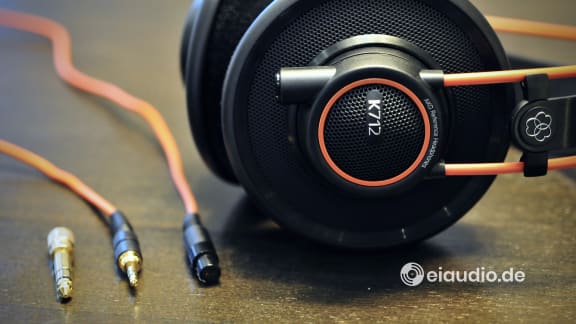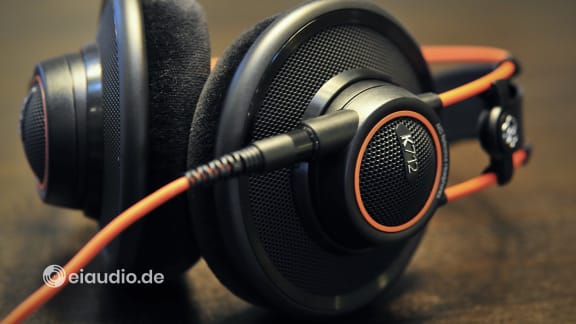AKG K712 Pro
Published: 18/12/2021
Manufacturing date: 2021
Author: Karsten Hein
Category: Gear & Review
Tag(s): Headphones
My interest in headphones did not stem from the desire to listen for pleasure or experience superior sound quality when travelling. Nor did I need to be especially quiet when our kids were asleep. They had grown up with music playing way past their bedtime and had hardly ever had trouble sleeping - at least not because of music playing. No, my interest rather resulted from the need to monitor the audio recordings of interviews, digitised records, and - more recently - loudspeakers. My aim was to find headphones that would not colour the music and step out of the way for the original event to shine through. The audio-setup of our two Hi-Fi systems had become of such high quality that it was increasingly difficult to find headphones to accurately monitor their output. Differences in the performance of loudspeakers could be very subtle, of course.
For various reasons, I would have chosen good loudspeakers over headphones any day. A loudspeakers’ ability to excite the whole human body and interact with the dimensions of the room, but also its ability to set a real stage along with physical depth and proportion, all these aspects were missing from most headphones today. Luigi suggested that I try AKG’s K1000 electrostats which could be folded outward to create a better stage impression. But I decided that simpler more versatile headphones would be more suitable for my intended use as studio monitors. Was this perhaps again the point at which I was to wilfully ignore the expert’s advice and regret this for the days to come? Possibly, but at least I had a choice between experts now.
When purchasing the Beyerdynamic DT 990 Pro headphones some weeks earlier, I had ignored Jens’ advice on buying AKG monitors, instead. The DT 990 proved to be inadequate for my purpose, and I have since auctioned them off online. For my second attempt at finding good studio monitors, I decided to follow Jens’ lead on the AKG. Since the original model he had suggested had been on the market for a very long time, I decided to try two of the more recent models: the AKG K702 and the K712. From the reviews of both models that I found online, I was unable to make a definite decision between them. Both were open-back headphones that allowed for ambient noise and offered a somewhat unconstrained sound. However, the K712 came with stronger bass response of +3dB above the K702.
Some reviewers found the K702 to be more linear and therefore realistic in sound, whereas other reviewers had the opposite impression. Since most open designs had a natural bass-drop in comparison with their closed counterparts, I had a strong suspicion that the reviewers’ verdicts depended on their previous listening habits. Since I was looking for headphones to accurately reproduce the sound captured from our loudspeakers tests, I was going to use the loudspeakers as reference and then determine which of the two to keep, depending on their tonal proximity to the original. Since my impression would also depend on the periphery driving the headphones, I decided to use three sources: The Douk Audio T-3 Plus tube amp, our Zoom H4n Pro recorder that we had used to create the sound files, and our MacBook with its internal sound card. Both headphones had an impedance of around 60 Ohms which made them sufficiently easy to drive, even from the on-board sound card of a computer.
The K712 arrived first, and I was surprised to find that they were made almost entirely out of plastic. The drivers and the leather headband were the exception. This led to the headphones being very light-weight. AKG’s self-adjusting headband even increased this sensation by automatically exerting minimal pressure to the head. On the other hand, the plastic made them feel a little over-priced at first. The ear-pads were large, comfortable, and spacious inside. The feeling of openness increased during the first soundcheck. Whereas our Sennheiser HD 580 Precision headphones made the music sound close and intimate (with a sensation of resonances that were not completely kept at bay), the K712 gave the instruments some dimension and space to breathe. The darkness in between did not feel as artificial as it had on the DT 990 Pro, but rather natural and even elegant. There was a laid-back sensation to the music most likely coming from the lack of body resonances and the superior impression of order this produced.
On the Douk Audio T-3 Plus with GE tubes, the K712 produced a full and balanced sound. Transients and bass extension were cut a little shorter than I was used to from our loudspeakers. It was quite possible that this was caused by our Chinese headphone amp, the Denon CD player, or the non-existing break-in time of the diaphragms, headphone cable, solder joints, and the new plugs. I confess that I was a little sceptical at first when I saw that the K712 came with a detachable signal cord (two, actually) which would introduce more mass to the signal path. But seeing the benefit of changing between cords, I was inclined to accept it as an advantage, too. Having listened to the Sennheiser DH 580 and the Beyerdynamic DT 990 Pro, the K712 clearly had the upper hand in terms of clarity, sound-field, dimensions, tonal balance, etc.
Diana Krall’s song “No moon at all” showed less sibilance than I had heard on other occasions. However, the tonal colour of the piano was more accurate and relaxed than exciting. The double-bass being plucked in the beginning of the song was well-presented, but it could have been slightly more impressive, perhaps. I had heard this passage many times on speakers, often to jaw-dropping effect. The K712 remained accurate and in control with no aspect of the music falling out of place. String sounds came across as both sweet, varied, and nuanced. Via the MacBook Air sound card, I had the impression that male voices were artificially composed of their high and low aspects. However, I was not able to reproduce this effect via the dedicated headphone amp. It is no secret that one could rarely trust computers when it came audio reproduction, unless they were dedicated machines designed for the purpose of music.
Jörg Hegemann’s “Rock Me Mama”, on which Thomas Aufermann sang the lyrics, showed a little less bass-slam than I had previously been accustomed to from our loudspeakers, but they produced the vocals fully and accurately. Metallic sounds from the drum kit could have sounded a bit more shiny and aggressive, perhaps. I noticed that, even during faster sequences with many voices and multiple instruments playing simultaneously, the K712 managed to keep these separate, without them drowning each other out or overlapping. This superior sense of order was perhaps the most significant character trait of the K712. If asked, I would neither have wanted for myself nor recommended to others, headphones with less bass punch than these, as this would have taken us too far from the actual acoustic event of live music. Both physically and sonically, these modern AKGs headphones could be worn comfortably over extended periods of time without causing listening fatigue. AKG labelled them ‘Reference Studio Headphones’, and I could see that this description was accurate, as it placed order and control above sensation and excitement. These were sober headphones for a sober job, and I decided that I liked them.
AKG Company History
The Akustische und Kino-Geräte Gesellschaft m.b.H. was founded by Rudolf Hörige and Ernest Pless in Vienna, Austria in 1947. Rudolf was a physicist, and Ernst Pless was an engineer. The two men grouped their understanding of materials and mechanics to create loudspeakers, film projectors, and light meters. With the growing demand for media applications, AKG’s first microphone was used by Austrian radio stations, theatres, and Jazz clubs.
AKG achieved an international reputation for building excellent microphones with the launch of their D12 in 1953. This was far ahead of its time, and subsequent updates served to maintain its position. AKG also produced turntable cartridges during the 1970s and 80s.
The company established an American subsidiary in Los Angeles in 1985 and was taken over by the Harman group in 1994, which also operates Crown Audio. In 2017 the company facilities in Vienna (headquarters, manufacturing and engineering) were closed with most of Harman’s production facilities having been relocated to low-cost countries. At the time of writing this, Harman with its many brands is owned by Samsung.
Specifications
- Driver type: patented 2-layer diaphragm, dynamic
- Design: over-ear, open
- Frequency range: 10 - 39.800 Hz
- Nominal impedance: 62 Ohms
- Sensitivity: 105 dB (1mWatt, 1.000 Hz)
- Power rating: 200 mWats, max.
- Cables: 1x straight and 1x spiralled
- Connector: detachable via mini-XLR
- Cable length(s): 3m
- Plugs: 3.5mm + 6.3 mm jack
- Place of manufacture: Slovakia
- Weight: 300g (without cable)
- Year: 2021





